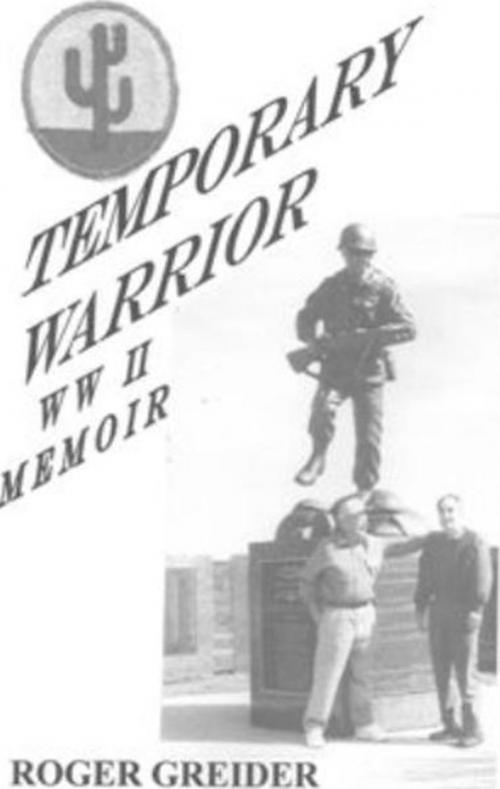| Author: | Roger Greider | ISBN: | 9781466075870 |
| Publisher: | Roger Greider | Publication: | December 6, 2011 |
| Imprint: | Smashwords Edition | Language: | English |
| Author: | Roger Greider |
| ISBN: | 9781466075870 |
| Publisher: | Roger Greider |
| Publication: | December 6, 2011 |
| Imprint: | Smashwords Edition |
| Language: | English |
TEMPORARY WARRIOR, WW II MEMOIR is the author’s account of his WW II experience from joining the Enlisted Reserve Corps until the end of the war in 1945. The book cover is a photo of 103rd Division monument at the Texas Visitor Center on I-35 near the Oklahoma border. A friend's hand is on my shoulder.
In 1942, as a freshman at Tulsa University I joined the Enlisted Reserve Corps. Within a few months I began three months of Infantry training. After that I went to the Army Specialized Training Program at Texas A & I in Corpus Christi, Texas. We were told by the authorities we were to be Army Engineers.
After two semesters the Program was discontinued. Commissioned Officers and Noncommissioned Officers were waiting for us at Camp Howze, and the ASTP men filled the ranks as Privates; we had become the 103rd Infantry Division. I had broken a leg in a Physical Education class at A&I, so after Convalescence Leave I joined the Division late.
Our trainers had no experience in fighting the war we were in. They had to use books written at the time of WW I or before. Along with other archaic practices, I learned how to yell, growl and stick a bayonet into a bundle of straw. The important part of the training was to convince us that killing was OK.
Finishing our training in October, 1944, we went by train and troop ship to Marseilles on the southern coast of France and then by train and truck to the front line near St. Die. My training had not transformed me into a soldier, but on my first day of combat I at least learned to be afraid. In my squad of eleven men, four were killed, two were wounded, and only two other men were there with me on the second day.
In December, after fighting through the Vosges Mountains we reached the Siegfried Line, a defensive position of which we knew nothing. Our officers and trainers had also known nothing about it. And while our men were being killed by machineguns in the well hidden pillboxes, Hitler launched The Battle Of The Bulge. Our Division, south of there, attempted to advance into Germany by attacking at Sessenheim, but failed, having to make a strategic withdrawal. And men were sent north to help deflate the Bulge.
At Sessenheim I was maturing as an infantryman, carrying a BAR (Browning Automatic Rifle). After the Bulge, two raids behind enemy lines were ordered. In both we were to kill everyone in German uniform and then retreat. A Lieutenant from Headquarters briefed us, “The books all say ‘Use the knife,’” and he said we should use a gun only if necessary. We thought he was nuts. One raid was assigned to my Company. The other was a Battalion effort, raiding Rothbach, where I led the assault on two different buildings.
On March 15th after weeks of snows and thaws, the Division began a thrust toward the Siegfried Line again. I became bold and aggressive, and I was promoted to Staff Sergeant, taking over the squad and leading many attacks as we advanced rapidly. At one point the Company gave me a smoke screen, allowing me to escape from a pillbox machinegun. Then with a Company of tanks we broke through the Siegfried Line into Germany.
From Michelstadt, Germany I went on furlough to London, and I was in Paris going back when the war in Europe ended. I joined the Company in the Brenner Pass between Austria and Italy and we moved to Barwise, Switzerland.
A few weeks later the 103rd Division was decommissioned and I was sent to the 5th Division, which was scheduled for the Pacific Theater. But after a thirty day delay in route the war ended and I was discharged.
The Epilog is about the post war Company A reunions and the monuments to the Company and Division. It includes a short account of the trip my wife and I took in 2002 to retrace the route I took through Europe during the war.
TEMPORARY WARRIOR, WW II MEMOIR is the author’s account of his WW II experience from joining the Enlisted Reserve Corps until the end of the war in 1945. The book cover is a photo of 103rd Division monument at the Texas Visitor Center on I-35 near the Oklahoma border. A friend's hand is on my shoulder.
In 1942, as a freshman at Tulsa University I joined the Enlisted Reserve Corps. Within a few months I began three months of Infantry training. After that I went to the Army Specialized Training Program at Texas A & I in Corpus Christi, Texas. We were told by the authorities we were to be Army Engineers.
After two semesters the Program was discontinued. Commissioned Officers and Noncommissioned Officers were waiting for us at Camp Howze, and the ASTP men filled the ranks as Privates; we had become the 103rd Infantry Division. I had broken a leg in a Physical Education class at A&I, so after Convalescence Leave I joined the Division late.
Our trainers had no experience in fighting the war we were in. They had to use books written at the time of WW I or before. Along with other archaic practices, I learned how to yell, growl and stick a bayonet into a bundle of straw. The important part of the training was to convince us that killing was OK.
Finishing our training in October, 1944, we went by train and troop ship to Marseilles on the southern coast of France and then by train and truck to the front line near St. Die. My training had not transformed me into a soldier, but on my first day of combat I at least learned to be afraid. In my squad of eleven men, four were killed, two were wounded, and only two other men were there with me on the second day.
In December, after fighting through the Vosges Mountains we reached the Siegfried Line, a defensive position of which we knew nothing. Our officers and trainers had also known nothing about it. And while our men were being killed by machineguns in the well hidden pillboxes, Hitler launched The Battle Of The Bulge. Our Division, south of there, attempted to advance into Germany by attacking at Sessenheim, but failed, having to make a strategic withdrawal. And men were sent north to help deflate the Bulge.
At Sessenheim I was maturing as an infantryman, carrying a BAR (Browning Automatic Rifle). After the Bulge, two raids behind enemy lines were ordered. In both we were to kill everyone in German uniform and then retreat. A Lieutenant from Headquarters briefed us, “The books all say ‘Use the knife,’” and he said we should use a gun only if necessary. We thought he was nuts. One raid was assigned to my Company. The other was a Battalion effort, raiding Rothbach, where I led the assault on two different buildings.
On March 15th after weeks of snows and thaws, the Division began a thrust toward the Siegfried Line again. I became bold and aggressive, and I was promoted to Staff Sergeant, taking over the squad and leading many attacks as we advanced rapidly. At one point the Company gave me a smoke screen, allowing me to escape from a pillbox machinegun. Then with a Company of tanks we broke through the Siegfried Line into Germany.
From Michelstadt, Germany I went on furlough to London, and I was in Paris going back when the war in Europe ended. I joined the Company in the Brenner Pass between Austria and Italy and we moved to Barwise, Switzerland.
A few weeks later the 103rd Division was decommissioned and I was sent to the 5th Division, which was scheduled for the Pacific Theater. But after a thirty day delay in route the war ended and I was discharged.
The Epilog is about the post war Company A reunions and the monuments to the Company and Division. It includes a short account of the trip my wife and I took in 2002 to retrace the route I took through Europe during the war.















